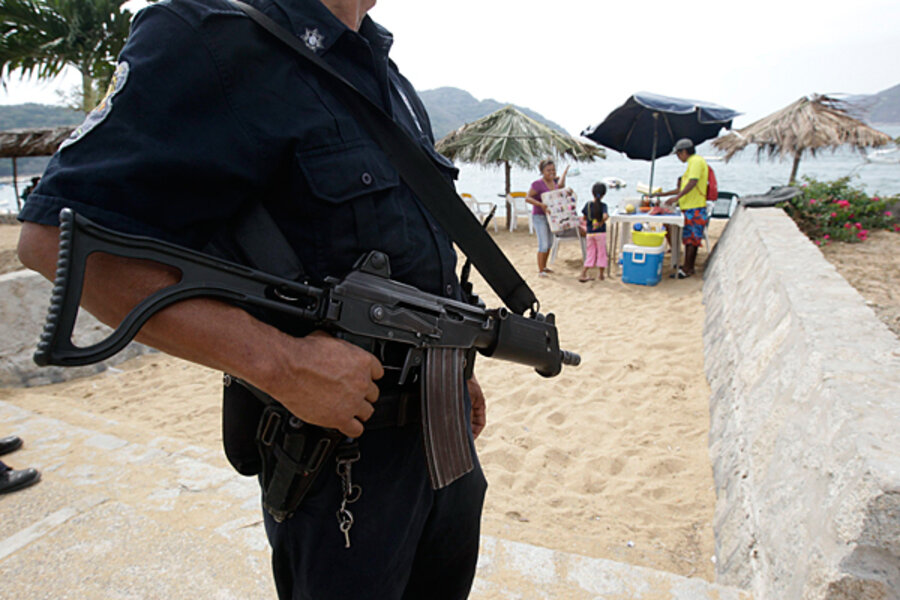Can Mexico's vigilante militias trade ski masks for police badges?
Loading...
| MEXICO CITY
Some townspeople in southern Mexico who have taken up arms in the name of self-defense may be given a chance to trade in their masks for official uniforms.
Bucking the federal government’s statements decrying impromptu militias, the governor of Guerrero has proposed legitimizing the armed groups in the tradition of the state’s autonomous community police forces. It’s a controversial proposal that could create friction as authorities wrestle with the emergence of armed groups whose origins are not always clear. The move could influence how officials respond to similar movements in neighboring states.
Organized crime and drug trafficking have hit far-flung rural towns especially hard, where official security forces are often weak, ineffectual, or co-opted by criminals.
Back in January, fed up with extortion and kidnappings, the residents of Ayutla de los Libres, in the southwestern state of Guerrero, pulled on ski masks, armed themselves with shotguns, and began patrolling their streets. The group’s detention of dozens of suspected criminals and its plan to hold public trials, as well as highway checkpoints to keep out strangers – including soldiers – put the federal government on alert.
“The real problem is the incapacity of the state to ensure security and procure justice,” says Juan Salgado, a Mexico security expert at CIDE, a public university in Mexico City.
Armed groups have also formed in the states of Michoacan and Veracruz. In Michoacan, west of Mexico City, federal forces recently detained members of one heavily armed cell believed to be working not for the protection of a community but as strongmen for a cartel.
Guerrero Governor Angel Aguirre announced last week that he would submit a bill to the local legislature creating a legal framework for the militias. It’s a tack that has been tried before – with apparent success – in the state.
A wave of violence in the early 1990s prompted locals to take up arms in the name of self-defense; a network of largely indigenous communities created the Regional Coordinator of Community Authorities (CRAC) in Guerrero, which still exists, albeit in a legal gray area as a system parallel to that of federal forces.
Under that network, 108 communities in Guerrero police themselves and impart justice locally. Volunteers don uniforms, carry credentials, and have received training and education in their roles – although there are concerns about fair trials and professionalism.
The governor told local press that regulations would prohibit the use of masks and limit the weapons self-defense groups could carry, although further details of the proposed initiative have not been made available. A government spokesman could not be reached for comment.
Still, the new groups emerging today face a different, more complex threat than in the 1990s, says Mr. Salgado: They’re fighting organized crime, not common crime. And their true purpose (or the source of their weapons, which are largely illegal in Mexico) isn't always clear. That could make any strategy of legitimizing their existence risky, he says.
Ernesto López Portillo, director of the Mexico City-based Institute for Security and Democracy, says the armed groups are a consequence of the state’s inability to ensure citizens’ safety in the face of pervasive organized crime. Still, he adds, “in no way should the replication of armed groups be accepted.”
“The worst path is the duplication of these armed groups because it reproduces violence,” Mr. López Portillo says. “The risk," he says, is giving legal authorization to armed groups that "still don’t represent a professionally designed police force."
Mexico – where police corruption is rampant and few crimes are ever solved – has a long history of self-defense movements.
One well-known example is the Zapatistas, who declared their autonomy in an armed mobilization in 1994 that eventually resulted in the group of indigenous communities governing themselves independently in southern Chiapas state. Two years ago, in Cheran, Michoacan, an indigenous community successfully armed itself against illegal loggers believed to be part of violent criminal groups [Read The Christian Science Monitor's coverage of Cheran here].
Mexico’s attorney general and the head of its human rights ministry have both stated that all self-defense groups are illegal. President Enrique Peña Nieto has proposed police reforms that would organize disparate state and local forces under a single command. While that could shake up the local order, the president's proposal would leave it to states to determine how best to incorporate local forces.
Still, the self-defense groups often organize in regions that have historically been ignored or abandoned by the government. And that, says Lopez Portillo, is the real root of the problem.








